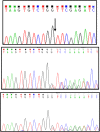A Novel Mutation in SNX10 Gene Causes Malignant Infantile Osteopetrosis
- PMID: 29090071
- PMCID: PMC5650739
A Novel Mutation in SNX10 Gene Causes Malignant Infantile Osteopetrosis
Abstract
Background: Osteopetrosis is a group of genetically heterogonous diseases and the main feature of that is increased bone density due to osteoclast's abnormality. It has three clinical forms based on inheritance pattern, severity and age of onset: the dominant benign form (ADO), the intermediate form (IRO) and the recessive severe form (ARO). One of the recently discovered genes for ARO form is SNX10 that accounts for 4% of affected persons by this type.
Methods: In this paper, a 15 years old girl affected by osteopetrosis has been analyzed for detecting causal mutation in known osteopetrosis genes. To get it done, amplified exons of the genes were sequenced and then were analyzed.
Results: Direct sequencing of SNX10 gene showed a homozygous c.43delG variant in the patient. Both healthy parents were heterozygous for this variant. In silico analysis revealed that this novel variant can be considered as the cause of disease in the patient.
Conclusion: In this paper, a girl affected by osteopetrosis with a novel deletion in SNX10 gene was reported.
Keywords: Iran; Mutation; Osteopetrosis; SNX10.
Figures


References
-
- Del Fattore A, Cappariello A, Teti A. Genetics, pathogenesis and complications of osteopetrosis. Bone 2008; 42 (1): 19– 29. - PubMed
-
- Hamosh DA. Online Mendelian Inheritance in Man McKusick-Nathans Institute of Genetic Medicine , Johns Hopkins University School of Medicine: Johns Hopkins University ; ; 1966–2015 . [cited 2015 04.12.2015]. Available from: http://www.omim.org/.
-
- Sobacchi C, Schulz A, Coxon FP, Villa A, Helfrich MH. Osteopetrosis: genetics, treatment and new insights into osteoclast function. Nat Rev Endocrinol 2013; 9 (9): 522– 536. - PubMed
Publication types
LinkOut - more resources
Full Text Sources
